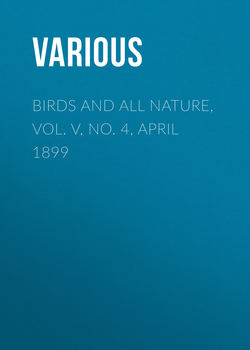Читать книгу Birds and All Nature, Vol. V, No. 4, April 1899 - Various - Страница 3
THE AMERICAN BARN OWL
Оглавление(Strix pratincola)
LYNDS JONES
OUR barn owl belongs to the tropical and warm temperate genus Strix, which is scattered widely over the greater part of the earth in the tropical and subtropical parts of both hemispheres, and scatteringly into the temperate zones. In Europe one species is common as far north as the British Isles, while our own bird is found as far north as southern New England in the East, Ontario, Michigan, Wisconsin, and southern Minnesota in the interior, and Oregon and Washington on the Pacific coast. It is hardly common anywhere except in the extreme southwestern part of the United States, where it is the most abundant owl in California. It is rare or casual north of about the fortieth parallel. But two specimens have been brought to the Oberlin College Museum in twenty years, one of which was found dead in a barn a mile east of Oberlin in December of 1898.
The barn owl is the most nocturnal of all our owls, although he can see perfectly in the brightest day. Not until twilight does he issue from his secure hiding-place to do battle with the farm and orchard pests. Then he may be seen sailing noiselessly over orchard and meadow in quest of any mischievous rodent that may be menacing the farmer's prospects. He seems to single out intelligently the ones that do the most injury, destroying large numbers of pouched gophers and other annoying and destructive creatures, asking only in return to be left in peace in his hiding-place. The farmer certainly has no better friend than this owl, for he destroys poultry only when driven to it by the direst necessity. In the East, his food consists largely of rats and mice; in some parts of the South the cotton rat is the chief diet; while in the West he feeds principally upon the gopher (Thomomys talpoides bulbivorus) and the California ground squirrel (Spermophilus grammurus beecheyi), according to Prof. B. W. Evermann. It seems pretty certain that fish are sometimes captured and eaten.
This owl undoubtedly breeds, though sparingly, in all suitable localities wherever it is found, and probably migrates more or less in the northern part of its range. In Europe it nests in old ruins, towers, and abutments of bridges, but our American species finds few such places, so he resorts to hollow trees, caves, crevices in rocks, and banks, and even to burrows in the level ground, as we find to be the case in parts of the West. The burrows are undoubtedly the deserted burrows of some other animal. In the eastern parts of the country the owls frequently nest in buildings. It is well known that a pair occupied one of the towers of the Smithsonian building in the city of Washington in 1890, raising a brood of seven young. It is stated that the period of incubation is from three to three and a half weeks, and that brooding begins with the deposit of the first egg; thus there may be fresh eggs and young in the same nest. This accounts for the long period of incubation.
The eggs are pure white, usually from four to seven in number, rarely twelve. They are rather longer in proportion than those of the other owls – in about the proportion of 1.30 × 1.70. But the average size is variously given by the various authors.
It seems a little curious that there should be such a marked difference between the hawks and owls as regards nest material. They belong to the same order of birds, and yet the hawks build their own nests, collecting the material and arranging it much after the fashion of higher birds, while the owls make practically no nest, at the most collecting a little material and scattering it about with little regard for arrangement. But the difficulty disappears when we realize that the owls have probably always nested in hollows which require no nest material, while the hawks, if they ever nested in hollows, have long ceased to do so, building their nests among the branches of trees, where a relatively large amount of material is necessary. The few species of hawks which now nest in hollows have gone back to that method after a long period of open nesting and have retained the nest material even here where it seems unnecessary.
The monkey-like appearance of this owl, emphasized by his tawny color and screeching voice, gives him a decidedly uncanny appearance. His plumage is unusually soft and fluffy, but is too thin to enable him to withstand the rigors of a northern winter. Curiously enough, the feathers on the back of his tarsus grow up instead of down, giving that part of his plumage a rather ungroomed appearance. One edge of his middle toe-nail is toothed like a comb.
During the nesting season only a single pair can be found in a place, but at other times the species is more or less gregarious in the regions in which it is numerous. Often a dozen individuals may be found in a company. The extreme seclusiveness of the birds during the day makes it very difficult to find them, and they are undoubtedly more numerous than generally reported, and are likely to be present in many places where their presence is not now suspected. They seek the darkest and most secluded corner possible and remain quiet all day. Their noiseless flight might easily be mistaken for that of the whippoorwill. Let us hope that the good qualities of this owl will be fully recognized before his hiding-place is discovered.
